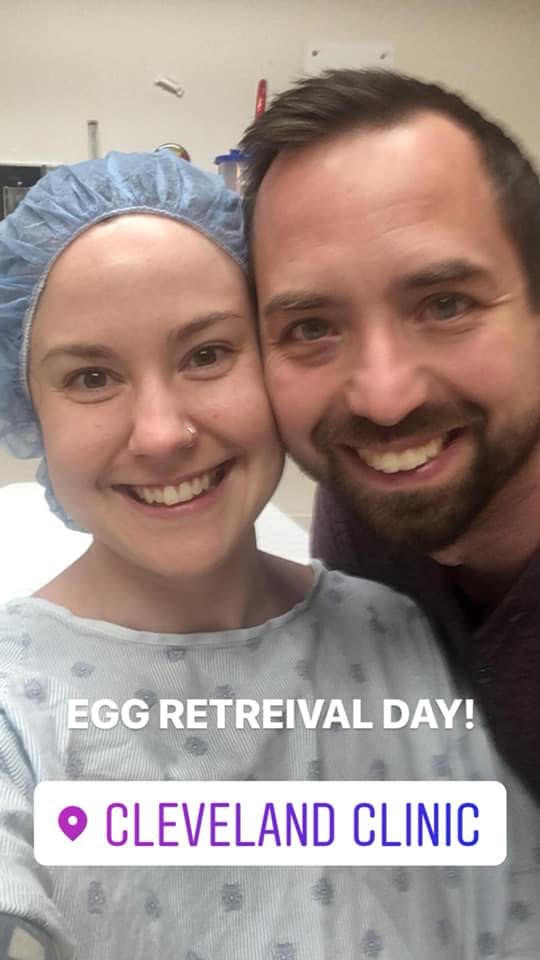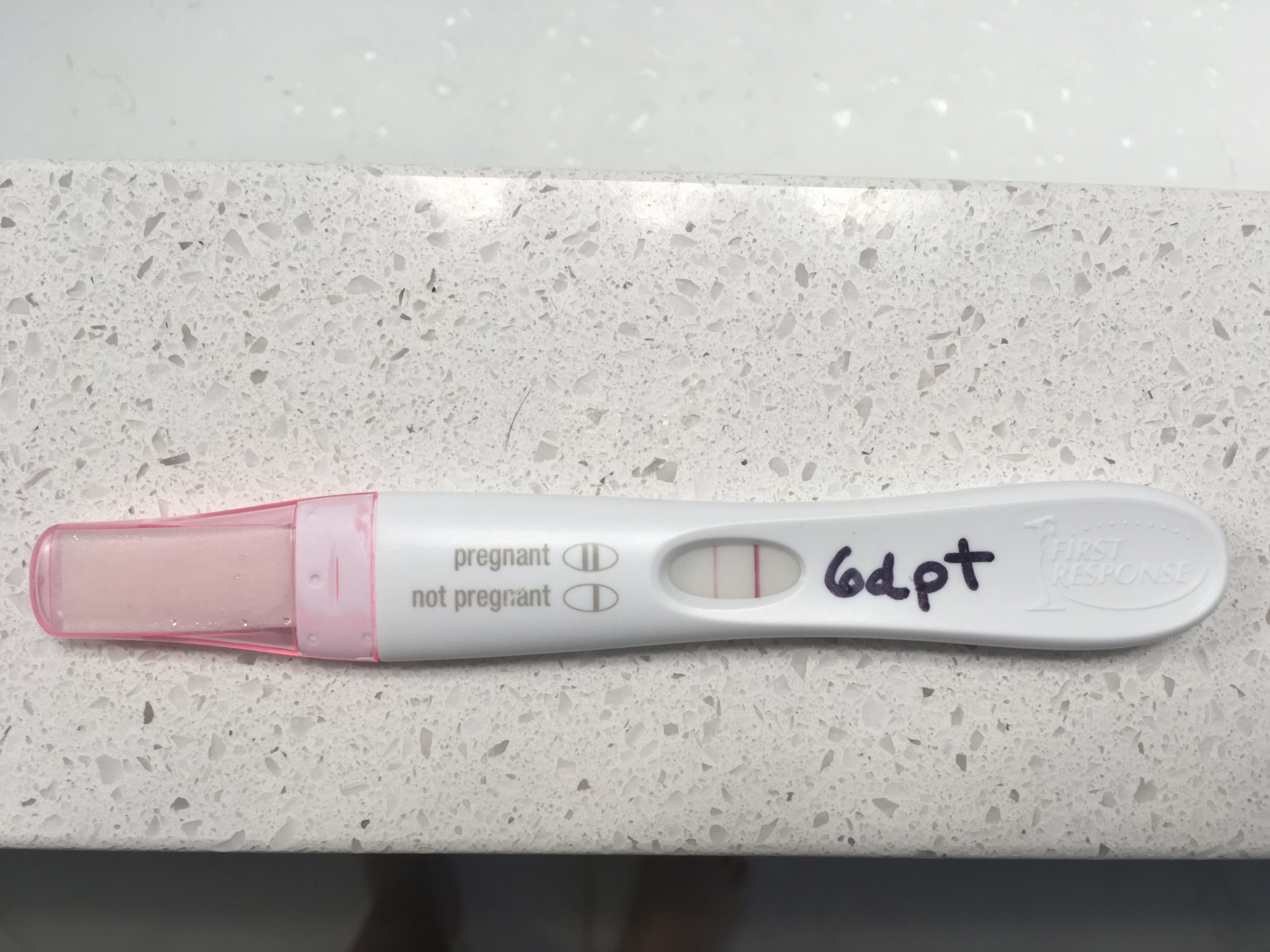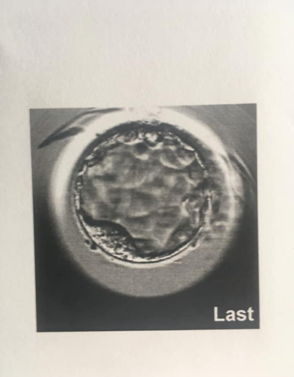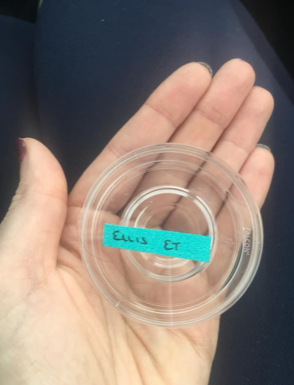Our IVF Journey

If you’ve been following me for a while you know that we did IVF (In vitro fertilization) to conceive our daughter, Olive. She is also our rainbow baby. I share our story of loss here. I won’t get into all the before journey, but it was long and fraught with a lot of tears, fears over money (a single round of IVF averages $15,000-$20,000 and insurance generally doesn’t cover it), diagnosis, failed IUI’s, more tears, confusion and anger… pretty much all the emotions one can have bundled into this awful package you never wanted to have to open. There is some solace when I speak with other mom’s who have walked a similar path as me. We’re all in this weird club that we didn’t sign up for, but thankfully there is a lot of support here!
So I want to talk about IVF in general in case you’ve never heard of it or are in the beginning stages of the process.
INITIAL PREP FOR IVF
A cycle of IVF can start one of two ways— timed with birth control or naturally as your cycle begins. Our doctors at the Cleveland Clinic like to control the whole process so they put me on birth control so they knew exactly how to time everything. There are a LOT of appointments, so prepare for that. They do a baseline ultrasound to check to see if your uterine lining is at the right thickness to begin your follicle stimulators. The blood work also let the doctors know where my hormones were at, also to make sure that my body was ready to start the process of getting pregnant.
MAKING EGGS

A subcutaneous injection is given into the fatty tissue just beneath the skin. Many fertility drugs are delivered this way. But none of us look this happy while injecting ourselves lol
Once your body is ready, you begin Follicle Stimulators (Subcutaneous injections are commonly required for hormonal fertility drugs.). Follicles are where your eggs are released from during your cycle. It is normal for women to have 1 follicle (sometimes more will grow, but 1 is pretty typical) that matures enough to release an egg. During IVF, the goal is to get as many eggs as possible, so Follicle Stimulator shots are administered in the belly to help grow as many follicles as possible to maturity. A follicle is considered mature when it is 18mm or just over 2cm.
For us, we did follicle stimulator shots for 10 days. On day 7 of stims, we started using a medication to prevent early ovulation. Ovulation is prevented for a few days to help more follicles reach maturity. After 3 days of ovulation prevention, it was time to do what is called a “trigger shot.” This shot preps the body for egg retrieval. 36 hours (literally to the hour) after the trigger shot is administered you go in for your egg retrieval. I found the trigger shot part to be stressful because it’s such a timed thing. I had appointments every day for a few days for ultrasounds and bloodwork to see exactly when I needed to take the trigger. Our IVF nurse at The Cleveland Clinic was great and called me literally every day.
EGG RETRIEVAL
I arrived at the IVF fertility clinic early in the morning and waited for another blood draw. Once that test was done, I was waiting in the surgery area for my name to be called. Once called, I was taken to the back and my husband was instructed to wait in the lobby.
In the back, the nurse started to prep me for the procedure. This included general health tests and any prior surgery experience with anesthesia. She then had me dress into a hospital gown, booties, and put my hair into a net. I was sitting in a pre-op area with another patient (separated by a cloth curtain) and hooked up to an IV with saline.
Once all the vitals were checked and my IV was set, they brought my husband in to sit with me for several minutes before they were ready to bring me into the OR.
I met with the anesthesiologist who explained what was going to happen during the procedure, answered any questions I had, and then wheeled me off. The doctor who would be performing the procedure then came in, introduced herself, and explained what she was going to do during the procedure. She explained that they’d wash me up with a saline solution before any operation began, then they would use a sonogram to navigate a needle into the ovaries to extract the eggs. It sounds scary, but you’re asleep during the whole thing!
We were absolutely thrilled when I woke up from surgery and they were able to collect 23 eggs! The average is 9-15 so I was feeling proud of my body for cranking out those follicles!

FERTILIZATION
After the Egg Retrieval, they attempt to fertilize the egg and the sperm. There are two different ways to fertilize embryos. One process is the traditional “test tube baby” way where they put the egg and the sperm in a test tube with some fluid and allow them to fertilize on their own. And then the other way is called ICSI (intracytoplasmic sperm injection) where they inject an individual sperm into an egg. Due to our particular reasons for infertility, we had a finite amount of sperm to work with so ICSI was the best route for us.

ICSI depiction
Once your baby embryos are fertilized, it is time to let them grow for a few days. This process is nerve wracking. You get a call from the Embiologist every day with an update on the embryos and if they’re splitting like they should be. We had some late bloomers that looked like they wouldn’t make the cut, but finally got where they needed to be. Of the 23 eggs that were retrieved, 13 fertilized and made it to blast – They have to get to a certain stage before they can be transferred back into the body or frozen for a later transfer date.
The decision of a “Fresh Transfer” versus a “Frozen Transfer” comes down to a few things:
- Is your body ready?
- Have the embryos grown enough?
- The number of Eggs Retrieved (to avoid OHSS- ovarian hyperstimulation syndrome)
There’s some debate on whether fresh vs frozen transfer is more effective, but our doctors found they had almost the same results with both. We were super eager to get pregnant and didn’t want to wait another cycle if all looked well and I felt well enough.
TRANSFER
Before your transfer (whether it is a Fresh or Frozen transfer), you take progesterone. Progesterone helps prepare a woman’s body to get pregnant and then also helps a woman stay pregnant once she becomes pregnant. There are different forms of progesterone that are taken— pill, suppository, or injection. For frozen transfers, progesterone is administered via injection and is taken the weeks leading up to the transfer and also for a number of weeks after the transfer. I did the suppository since we were doing a fresh transfer.
The fertilized embryo is thawed (if frozen) and transferred into the woman’s body. It is recommended that the woman stay down and rest for at least 3 days after the transfer.
The Transfer was also a relatively simple procedure. The Embryologist and Doctor and a Nurse Practitioner were all present for the Transfer. The Embryologist showed us our embryo in real time via a microscope video. I verified that the name and embryo were ours. Then they brought in the syringe and handed it over to the doctor. He then transferred the embryo from the syringe to my body through my cervix and into my uterus. After the doctor was finished, the Embryologist checked the syringe to make sure that the embryo didn’t get stuck in the syringe and that it transferred properly. Once that was verified, we were done and ready to go home and we were officially Pregnant Until Proven Otherwise — aka PUPO.
AFTER TRANSFER
After the transfer, the dreaded “2 week wait” (as it is known in the infertility world) happens. After 10 to 14 days, you go back in to your doctor, where they take a blood pregnancy test and let you know whether or not you are pregnant from your IVF cycle. If you are pregnant, then at 7 or 8 weeks you will go in for your first ultrasound. The fertility clinic will continue to monitor your pregnancy up to 12 weeks and then you graduate from the fertility clinic to a typical OBGYN.
I cheated and tested at day 6 post transfer. We laid the test on the counter and set a timer and went and laid in bed and snuggled until the timer went off. I had such a knot in my stomach. We went in and I WAS PREGNANT! And the line was already DARK! So I knew this was going to be a sticky baby! Our last pregnancy was such a faint line that I almost thought I wasn’t pregnant at all.

Easy peasy, right? Hahaha. Not. It’s taxing. Your body swells up like a big balloon and you look 4-5 months pregnant after 10 days, so that’s cute. But for most of us, we’ll do anything to have a baby and it’s all worth it.

6 weeks pregnant but looking like 20 from how much fluid I retained from the egg retrieval process.
RISKS
Injectable fertility medicine risks include:
- Mild bruising and soreness at the injection site (using different sites for the injections can help)
- Nausea and, occasionally, vomiting
- Temporary allergic reactions, such as skin reddening and/or itching at the injection site
- Breast tenderness and increased vaginal discharge
- Mood swings and fatigue
- Ovarian hyperstimulation syndrome (OHSS)
EGG Retrieval Risks:
- Mild to moderate pelvic and abdominal pain (during or after). In most cases, the pain disappears within a day or two and can be managed with over-the-counter pain medications.
- Injury to organs near the ovaries, such as the bladder, bowel, or blood vessels. Very rarely, bowel or blood vessel injury can require emergency surgery and, occasionally, blood transfusions.
- Pelvic infection (mild to severe). Pelvic infections following egg retrieval or embryo transfer are now uncommon because antibiotic medicines are usually given at the time of egg collection. Severe infection may require hospitalization and/or treatment with intravenous antibiotics.
- Rarely, to manage a severe infection, surgery may be required to remove one or both of the ovaries and tubes and/or uterus. Women who have had pelvic infections or endometriosis involving the ovaries are more likely to get IVF-related infections.
Embryo transfer risks:
- Mild to moderate pelvic and abdominal pain (during or after). In most cases, the pain disappears within a day or two and can be managed with over-the-counter pain medications.
- Very rarely, an infection may develop, which can usually be treated with antibiotics.
GENETIC TESTING
Tests can be done to make sure embryos are viable (that they will be actual babies. about 50% of embryos are not viable). Genetic Testing can be done to ensure that embryos will be viable. Our doctor advised against doing genetic testing because my husband and I both had been tested to make sure we didn’t have issues that would cause problems with a child together. Sometimes you lose embryos in the freezing and thawing process as well, and our doctor didn’t think it was advantageous for us to do the genetic testing.
Some people will do genetic testing so they can plan what gender their baby will be. Some doctors are not comfortable with this process and will refuse treatment, but many have no problem if you have your heart set on a certain gender baby.
HOW MANY EMBRYOS TO TRANSFER
Most of the time 1-2 embryos are transferred (it depends on maternal age. Women older than 40 often have multiple embryos transferred). The number of embryos transferred doesn’t necessarily mean the number of babies that are born. Embryos can split once they are transferred producing multiples (twins, triplets, quadruplets, etc.).
We transferred a single embryo that had the best grade – and that little embryo became our sweet Olive! I still have her little petri dish that was her very first home. She was the little embryo that could and was continuing to divide while they were sucking her up in the tube to transfer her. I am still so amazed by the whole process!


WHEN IVF DOESN’T WORK
Sometimes none of the embryos implant and pregnancy does not occur. IVF, unfortunately, is not a guarantee. Not getting pregnant from IVF can be devastating. I have watched multiple documentaries and have known people personally who have had to do multiple rounds of IVF before it worked, or are still, sadly, childless. I cannot imagine the stress of it all. We were so very lucky to have such a wonderful outcome.
So if you or someone you know needs to do IVF to grow your or their family, send them love often. Tell them you’re aware of their situation and you care about them. Cheer them on because IVF can be so, so taxing physically, mentally, financially, and emotionally.
So if you’re in the process of fertility treatments, I see you mama. I’m here rooting for you! And if you have any questions or need someone to vent to, I’m here. My email, DMs and heart are open to you! And I hope one day soon to celebrate with you over that “pregnant” test.

Some other posts you may like about our pregnancy journey and birth:
Our Maternity Photos on Oahu
Our Baby Shower and Name Reveal
The Birth Of Olive Amelia
Why I Chose An Unmedicated Birth
Nutrition & Fertility | As Told By A Functional Perinatal Nutritionist